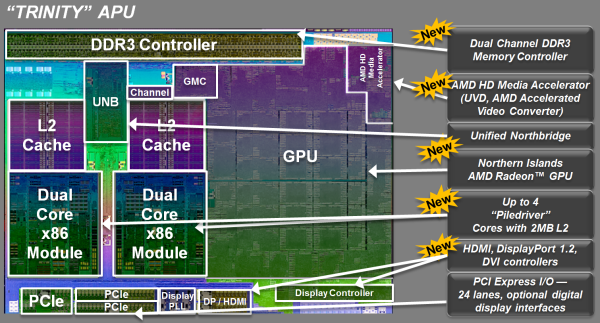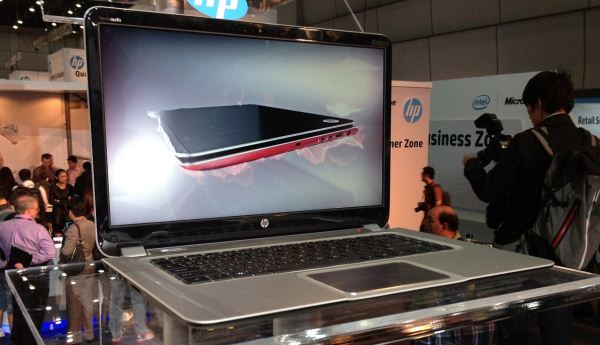The AMD Trinity Review (A10-4600M): A New Hope
by Jarred Walton on May 15, 2012 12:00 AM ESTConclusion: What Makes a Trinity?
I have often wondered about where AMD came up with the codename Trinity (other than the river name, of course). Was it a reference to this being AMD’s third APU? Or maybe AMD was gunning for the Holy Trinity of Performance, Battery Life, and Cost—get wins in all three areas and you’d have a guaranteed best seller! If that’s what AMD was hoping to accomplish, they’ve got a good foundation but we’ll need to see what the laptop OEMs come up with before issuing a final verdict.
To recap, Trinity is AMD’s continued journey down the path they started with Llano. Both CPU and GPU performance have improved over Llano. The general purpose CPU performance gap vs. Intel is somewhere in the 20—25% range, while the GPU advantage continues to be significantly in AMD's favor. It is surprising that Intel's HD 4000 is able to win even in some tests, but overall AMD continues to deliver better GPU performance even compared to Ivy Bridge. It's worth pointing out that the concerns about AMD's battery life from a few years ago are now clearly put to rest. At least at the TDPs we've tested, AMD is easily competitive with Intel on battery life.
AMD's GPU accelerated software lineup this time around is significantly better than it was with Llano, but we're still not quite where we need to be yet. I will hand it to AMD though, progress is clearly being made. Battery life is generally a step forward vs. Llano, which is more than we've been able to say about Ivy Bridge thus far.
The improvements in Piledriver really appear to have saved Trinity. What was a very difficult to recommend architecture in AMD's FX products has really been improved to the point where it's suitable for mobile work. AMD couldn't push performance as aggressively as it would have liked given that it's still on a 32nm process and the APU needs to make money. A move to 2x-nm could help tremendously. Similarly the move to a more efficient VLIW4 GPU architecture and additional tuning helped give AMD a boost in GPU performance without increasing die size. Overall, Trinity is a very well designed part given the process constraints AMD was faced with.
As a notebook platform, Trinity's CPU performance isn’t going to set any new records but it’s certainly fast enough for most users; battery life isn’t at the head of the class, but it’s better than just about anything that doesn’t qualify as an ultrabook; and finally there’s the question of cost. That last item isn’t really in AMD’s control, as the final cost of a laptop is a product of many design decisions, so let’s do some quick investigation into laptop pricing.
If you figure on memory, motherboard, chassis, LCD, and storage as all being the same, a typical laptop will have a starting price point of around $300—for a cheap, injection molded plastic shell, 4GB RAM, a 5400RPM HDD, a 1366x768 TN panel, and a no-frills feature set. Take that same basic platform and you can make an Intel laptop and have a BoM (Bill of Materials) cost of around $450, or you can make an AMD laptop and your BoM might start at $400. Depending on what other upgrades an OEM makes, as well as marketing, R&D, and profit, and we end up at a final price tag that might be $600 for a Trinity laptop compared to $700 for an Ivy Bridge laptop. The problem is that AMD doesn't just compete against vanilla Ivy Bridge; it has to compete against all the existing laptops as well.
Right now, Llano A8 laptops at Newegg have a starting price of $480 for an A8-3500M Acer Aspire, and they range up to $700 for a 17.3” HP dv7. The highest performance laptop of the bunch is probably Samsung’s Series 3, which uses an A8-3510MX APU and goes for $680. I suspect we’ll see similar pricing for Trinity laptops. On the Sandy Bridge Core i3/i5 side of the fence, Newegg has a much larger selection of laptops, starting at $430 for a Lenovo G570, $550 for the cheapest Core i5 model (again from Acer), and going up to $680 or more for laptops with Core i5 and NVIDIA Optimus graphics. Or if you prefer some place other than Newegg, you can find Core i5-2450M with GT 540M in Acer’s AS4830TG for $600.
That pretty much defines the maximum price we should expect people to pay for Trinity, as Core i5 with Optimus will deliver better CPU and GPU performance based on our test results. Obviously there are other factors to consider, like build quality of the laptop(s), display quality, battery life, and features, but most people shopping for an inexpensive laptop are going to be looking at cost first and features second. On the other hand, if you want style as a consideration, HP’s new sleekbooks will have Trinity versions starting at $600 for 15.6” and $700 for 14”—though it’s not clear which APU you’ll get at those prices. As long as last-generation Sandy Bridge laptops are at clearing house prices, though, AMD’s partners are going to need to be under $600 for something like the A10-4600M laptop we’re reviewing today. Assuming they can manage that, Trinity should see plenty of volume with the back to school season coming over the next few months.
For those who are interested in more than just the bottom line, as usual the best laptop for you may not be the best laptop for everyone. Trinity in a 14” form factor like our prototype would make for a great laptop to lug around campus for a few years. It would be fast enough for most tasks, small enough to not break your back, battery life would be long enough to last through a full day of classes, and the price would be low enough to not break your bank. And if mom and dad are footing the bill, you even get to disguise the fact that it’s a gaming capable laptop by not having a discrete GPU specifically called out on the features list. On the other hand, if you’re after a higher performance laptop or you want a “real” gaming system—something that can hand high detail settings at 1600x900 for instance—your best bet continues to be laptops with an Intel CPU and a discrete GPU from NVIDIA, at least of the GT 640M level—I’d say AMD GPUs as well, but I’m still waiting for a better switchable graphics solution.
At this point, AMD has done everything they can to provide a compelling mobile solution. The difficulty is that there's no longer a single laptop configuration that will be "best" for everyone, and Trinity only serves to further muddy the water. Intel continues to offer better CPU performance, and if you need graphics—which mostly means you want to play games—they have a good partner with NVIDIA. AMD on the other hand is delivering better integrated graphics performance with less CPU power, and depending on what you want to do that might be a more well rounded approach to mobile computing. What we need to see now are actual laptops and their prices. To trot out a tired old saying once more, "There are no bad products; only bad prices." Now it's up to AMD's partners to make sure Trinity laptops are priced appropriately.












271 Comments
View All Comments
duploxxx - Tuesday, May 15, 2012 - link
if you want a more responsive laptop then buy an SSD, no one needs a laptop like the recent released Intel QC that turbo up all the way to 3.xxx whalhalle GHZ... its disc performance that is lacking most.jabber - Tuesday, May 15, 2012 - link
Exactly.My main laptop that I use most of the day is a 1.3Ghz CULV dual core from Intel. It does everything I need as a roving PC engineer. It benches the same as an old PentiumD 2.8Ghz.
If I put a SSD in it (which I want to) then I'd probably struggle to tell it apart day to day from one with a i5 cpu in it. CPU makes no difference to me.
Since dual cores came out in 2005/6 customers dont notice CPU upgrades all that much. You put a SSD in though and they notice that. Oh and if they can play WoW or Sims with the trimmings then they love that too.
Once again is it possible to add the latest Sims game to the benchmarks list? I dont play it myself but nearly every teens laptop I get has it on and I do get asked about good laptops for such a game.
BSMonitor - Tuesday, May 15, 2012 - link
Roving PC engineer? You mean you go to meetings and look at Word Documents. That hardly makes you the "average" user. The rest of us do the actual work.Spunjji - Wednesday, May 16, 2012 - link
Look up the meaning of the word average.CeriseCogburn - Thursday, May 24, 2012 - link
I'll monitor this one - since really old cpu's are way more than enough grunt since the trinity cpu sucks so badly and amd needs another gigantic hand of endless applause and praise by many frenetic amd fans flavoring up the place, we have learned one thing -All the old laptops are just fine. If you have a discrete of any sort, just use that. Add a little cheap ram, or add an SSD and it will beat trinity no problem all the time.
I thank all the trinity lovers for the hot tip - no one needs a trinity laptop.
BSMonitor - Tuesday, May 15, 2012 - link
Not for facebooking and trolling no. But I do real work on my PC.Spunjji - Tuesday, May 15, 2012 - link
Name the part of their CPU performance that doesn't meet the "good enough" metric. Seriously, convince me of your argument. So far it sounds like the usual crap I hear from people who don't understand the average user's needs.BSMonitor - Tuesday, May 15, 2012 - link
And you speak for "average" user like you know 100 million business users. I work in an IT shop. It took years of convincing to get off our P4's to Core2Duo. Because management takes the "good enough" stance like you. Waiting for email client base on JAVA runtime is NOT acceptable. Having Adobe reader pages lag when browsing them, re-sizing, is NOT acceptable. It STILL lags behind my Core i7 machine at home. And is VERY noticeable.Again, ebay, FB, yahoo... These are not the majority of users who care about performance.
In regards to 14 y/o's and housewives, yes, trinity rules. But then so did those laptops from 6 years ago. For them.
sumguy+4 - Tuesday, May 15, 2012 - link
So you are claiming that Intel's performance has improved by only 20% over the past 6 years??!?The article's summary stated that Trinity's CPU deficit vs Intel is 20-25% (while being cheaper and offering better video perf)
Show us the mobile CPU from 6 years ago that could even come close.
juampavalverde - Tuesday, May 15, 2012 - link
Wait... youre using and email client? haha... and its based on java? LOL!. And youre using adobe reader? ROTFL!A great part of the performance comes using software that gets all the juice from the hardware you have, there is no need even in the newest systems to use so bloated software.
By the way, i have an old HP 6910p with a C2D and 2 GB DDR2, GM965, it kicks butt and im thinking to throw a cheap SSD on it because is good enough to do any task i need to do (office apps, web apps, remote connections).